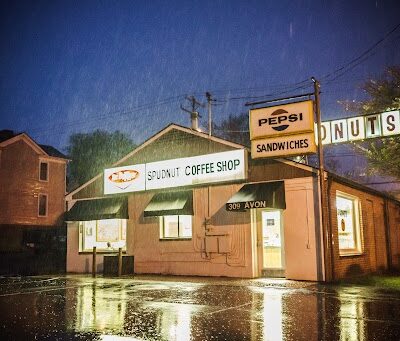Halsey Minor, the former local boy who made a fortune in California during the dot-com boom, has made quite a name for himself during the past year for his involvement in numerous squabbles and lawsuits. So it comes as little surprise that Minor has (you guessed it!) filed suit against Lee Danielson, his former agent on the 100-room boutique hotel project that’s come to a standstill on Charlottesville’s Downtown Mall.
|
Lee Danielson (left) and Halsey Minor during happier times. |
In a suit filed in Charlottesville Circuit Court February 20, Minor accuses Danielson and the project’s lender, Specialty Finance Group LLC, of eight counts of various forms of fraud and breach of contract.
Specifically, Minor alleges that Danielson colluded with the lender “and actively concealed the fact that the construction budget was not realistic until after the construction loan closed and Halsey Minor was personally on the hook for the cost to complete the project.”
He’s seeking $100,000 in compensatory damages, $350,000 in punitive damages, and whatever else he could get out of a trial. But most significantly, Minor wants out of his obligations to the hotel project, asking that he be released from the development agreement, the construction loan agreement and a restaurant lease that he had set up with Danielson for a high-end food joint to be called “minor’s.”
“It’s just more Halsey smoke screen,” Danielson tells C-VILLE. He points to numerous other lawsuits that Minor is involved with. “This lawsuit is fantasy land.”
He is currently embroiled in several other lawsuits. Auction house Christie’s is suing Minor for breach of contract, negligent misrepresentation and fraud, while Minor is suing Christie’s for breach of contract, fraud and various other complaints. The two disagree about whether Minor actually owned several artworks that he had Christie’s shop to a prospective buyer, and whether Christie’s was in the wrong for holding on to the artwork for several months.
In the fall, Sotheby’s auction house sued Minor for not paying $16.8 million for artwork bought at an auction. Minor countersued, but his case was dismissed in January.
Multiple media outlets report that Minor recently sued the owner of Florida horse racetrack Hialeah Park, John Brunetti, as well as the city of Hialeah after his efforts to purchase the racetrack for about $22 million were rebuffed.
Danielson, who’s not without his own issues concerning previous business deals, had originally planned to build the Charlottesville hotel himself, and even went to the trouble of having architectural renderings drawn up and getting the project through the (oft times) arduous process of Board of Architectural Review approval. But apparently Danielson didn’t have the capital, and he sold the property to developer Oliver Kuttner for $3.7 million in 2006.
Minor first talked to Danielson about the hotel project at 200 E. Main St. in late 2006, according to the lawsuit, and hired him as his “agent” for the project in November 2007. Minor reimbursed Danielson $312,000 for the design costs, and bought the property from Kuttner for $4.5 million.
In March 2008, Minor signed a promissory note of $23.7 million with Specialty Finance Group, a subsidiary of Silverton Bank in Georgia, and kicked in another $1.8 million to the project, bringing his total contribution to about $6.7 million. Minor and Danielson held a festive groundbreaking gala that month.
“It’s going to be like nothing people have ever seen,” said Minor, detailing the fabulous designers and artists who would be involved. “I think we’re going to be catalysts for a whole other [retail] tier to come.”
Almost one year later, what Charlottesville sees now is a 100′-tall shell of a building. No workers have been documented on site for weeks, though city Neighborhood Development Services Director Jim Tolbert says that his office hasn’t been notified of an official shut down. Local attorney Steve Blaine, who identified himself as a spokesman for the project six weeks ago, did not return calls for comment.
Word leaked this fall that the project was in jeopardy. The lawsuit lays out Minor’s version of events, which includes his explanations of the contradictory information that floated around during that time.
In November, Minor told various media outlets (including C-VILLE) that work would be coming to a halt because of issues with the lender. But Danielson contradicted Minor’s account, suggesting that Minor was at fault and that work would not stop. Court records indicate that construction contractor Clancy & Theys put $3.1 million worth of mechanic’s liens on the properties on November 12, but that those were settled November 20.
The lawsuit details that Danielson informed Minor in October 2008 of millions in additional costs, additions that Minor claims should have been included on the original document. They included plumbing fixtures, fire protection, wood flooring and a penthouse lounge, as well as 11 other line items. About November 3, Danielson requested a change order of $5.2 million, according to the lawsuit. It’s at that point that communications splintered to the point that both took their competing versions of the story to the media.
Minor claims in his suit that Specialty Finance Group “continued to insist…that Owner maintain the outward appearance that construction was proceeding, despite Owner’s wishes to slow down construction.”
Minor officially fired Danielson in late November. The lawsuit claims that Danielson “continued to wrongfully hold [him]self out as an authorized spokesman for Owner and the Project,” and that January 29, he e-mailed various companies once involved with the project to try to arrange a conference call about payment.
“The e-mail made false and defamatory comments about Owner insinuating that Owner would not pay the professionals associated with the Project or view them as a priority,” claims the suit. Minor also alleges that Danielson didn’t cut ties with local PR firm Payne Ross when asked in July.
Danielson says he plans to countersue. “He just beat me to the punch,” says Danielson, declining to comment on the specifics of the case. “He’s got nothing he can stand on. The fact that he can’t pay any of his bills is the problem.”
City spokesman Ric Barrick says that while there isn’t much the city can do, “we don’t have any doubt that it’s going to get done.” The only city requirement is that the developers complete utility work on Second Street necessary for the Mall rebricking, and, according to Barrick, that work has been done.
“They’ve invested a lot of money in that already,” says Barrick, and even given the current economy, “you don’t walk away from that kind of capital investment.”
If the Landmark is left a shell, it certainly wouldn’t be the first in the world. In Krakow, Poland, a 300′ tower started in 1975 is only now being completed—residents dubbed the building “Skeletor.” And in Austin, the federal government finally demolished the shell of an Intel building in 2007 after it sat untouched following the dot-com bust of 2001.
C-VILLE welcomes news tips from readers. Send them to news@c-ville.com.






